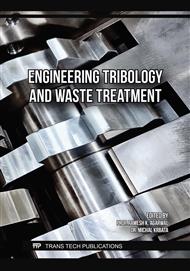p.61
p.71
p.77
p.83
p.89
p.97
p.103
p.109
p.117
A Comparative Study on Mechanical Properties and Morphology of PP/Waste Cement Composites with Using PP-g-MA as Compatibilizer and 3-Aminopropyl Triethoxysilane as Coupling Agent
Abstract:
In this study, waste cement is used as a filler in polypropylene (PP). Polypropylene composites with different loadings of waste cement particles (i.e.,0, 10, 20, 30, 40, and 50 phr (parts per hundred of resin)) were prepared by melt compounding with two roll mill and injection molding. Maleic anhydride grafted polypropylene (PP-g-MA) as compatibilizer and 3-aminopropyl triethoxysilane as coupling agent were selected to improve the interaction bonding between polypropylene and waste cement particles. The influence of the compatibilizer and coupling agent on the mechanical properties of PP/waste cement composites were studied. The results indicate that the incorporation of waste cement into the polypropylene matrix resulted in higher tensile modulus, flexural modulus, flexural strength, and hardness in addition to lower tensile strength, strain at break, and impact strength compared to polypropylene. The PP/waste cement composites with PP-g-MA exhibited higher flexural modulus and impact strength than PP/waste cement composites with 3-aminopropyl triethoxysilane at all waste cement loading. Nevertheless, the incorporation of 3-aminopropyl triethoxysilane improved the tensile modulus, tensile strength, flexural strength, and hardness of composites at high waste cement loading (i.e., 30-50 phr) compared to composites with PP-g-MA. Scanning electron microscope images of the fracture surfaces indicate that the addition of the compatibilizer and coupling agent in PP/waste cement composites resulted in improved adhesion between polypropylene and waste cement.
Info:
Periodical:
Pages:
117-124
Citation:
Online since:
June 2025
Keywords:
Price:
Сopyright:
© 2025 Trans Tech Publications Ltd. All Rights Reserved
Share:
Citation:


